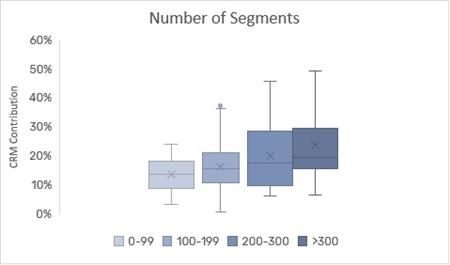
AI and the Retail Marketer’s Future
How AI transforms strategy and processes, driving the adoption of Positionless Marketing
Exclusive Forrester Report on AI in Marketing

Some people think that Cinderella is a children’s story. But any marketer immediately recognizes it’s a case study in personalization: the Prince was offering the right slipper to the right maiden at the right moment.
Happily, modern marketers don’t need to traipse through a kingdom on horseback to find their customers. But they do work hard to find the right fit between their products and each customer. In fact, research by Optimove has found that companies with more segments in their retention campaigns earn higher returns than companies with fewer segments. The difference is substantial: companies with more than 300 segments earn 74% higher CRM contribution than companies with less than 100 segments. Similarly, companies selling through three or more channels earn 67% higher average contribution than those using just one channel. And companies that take care to reach 90% or more of their active customers yield more than three times the revenue contribution than companies that reach between 60% and 70%.

Campaigns with more segments yield higher CRM contribution per customer. Source: Optimove
The moral of this story is clear: micro-segmentation pays big results. If your Fairy Godmother can make that happen with a wave of her magic wand, so much the better. If not, you’ll have to do it the hard way. Let’s see what that takes.
It All Starts with Data
You can’t make a pumpkin coach without a pumpkin, and you can’t make customer segments without customer data. In fact, you need a lot of customer data, because each bit can hint at slight differences which make different offers more effective. Details about the specific products a customer purchased are obviously important in knowing what they’d like to buy next. But so is information about when they bought, how often they buy, what messages they responded to, and what channels they used. Information about returns and service issues can also yield important insights.
Assembling this data across all interaction points to build a complete customer profile is essential. Then you’ll need to clean and prepare it for analysis, and keep it updated as new information is added. If a flock of birds isn’t available to do the work for you, a Customer Data Platform is the next best thing.
Building the Segments
Constructing a few segments is pretty simple, but building several hundred segments is another story. Of course, the goal isn’t just to create a lot of segments, but to find segments that improve results by delivering offers that precisely fit the needs of each group. Finding the subtle differences that produce increased response requires automated systems that test thousands of combinations to find the best approach. Much of this testing happens through data analysis while some involves actual experiments with in-market offers. Over time, the system learns from results and creates even more refined segments, continuing the process until additional splits fail to produce improved response.
Automation is essential, but fully autonomous systems are still the stuff of fairy tales. Human marketers need to supervise the automated systems to ensure they are using reasonable variables rather than chasing random variations in the data. Even more important, it takes human marketers to come up with promotional ideas to test: while automated systems are excellent at drawing inferences from historical information, they still can’t invent new offers that buyers might find appealing. A steady stream of creative ideas is needed to keep the marketing fresh and find improvements over previous offers.
Marketing Orchestration
Segment design is just the beginning. The real work begins when customers are assigned to different segments, promotions are sent, and results come in. AI-based automation is again essential to make the assignments, match the right promotion to each segment, execute the campaigns, and analyze response. Orchestrating this process is a continuous dance as customers swirl in and out of segments, promotions are sent at different tempos, and the segments and offers themselves evolve based on past experience. Changes ripple through the system as marketers introduce new products and promotions, extending the most successful, reducing use of the less effective, and allowing some to remain active in a limited niche. So long as the business itself continues, the movement never stops.
As with segmentation, the automated process must be supervised by humans. Their most basic job is to ensure the system continues to run. But they also keep the system from making logical-but-poor choices, such as overpromoting some groups, underpromoting others, and changing prices beyond acceptable limits. This requires the system to expose and explain its actions in ways that let its human supervisors understand what it’s doing and why. Although marketers may not allow the system to make major changes on its own, the system should show them potential opportunities and suggest how to take advantage of them.
Ironically, it’s also the supervisors’ job to disrupt the system. Automated optimization will create a stream of incremental improvements but may ultimately reach a plateau. Only marketers can add new inputs which substantially change the performance level. The changes won’t always be improvements, so one job of the system is to ensure mistakes are identified quickly and removed after minimum damage. When a change does work well, the system should amplify its effects as broadly and quickly as possible. As the improvements slow down over time, marketers can introduce new changes to start the cycle again.
Summary
Cinderella had it easy: all she needed to do was to show up at the ball and be gracious, and she had a Fairy Godmother to help. The real heroes of the story are the Prince’s staff, who worked without magic to keep hundreds of guests happy for days on end. For better or worse, marketers are more like party staff than party guests. Their job is to improve business results by giving each customer the best experience possible.
Micro-segmentation has been proven to create better business results. Marketers who fail to take advantage of micro-segmentation are earning less for their company and, ultimately, risk losing customers to other companies that provide a better experience. The tools to deliver micro-segmentation are complex and tightly integrated; many companies will need to rebuild or replace their existing systems to make it possible. The first step in this direction is to compare your existing systems with the requirements mentioned above – and detailed here on my full report. You’ll then be able to judge the best way forward.
Click here to access David Raab's full report, including a detailed breakdown of the system requirements – from customer data, segment identification, to message selection, and execution.
Exclusive Forrester Report on AI in Marketing
In this proprietary Forrester report, learn how global marketers use AI and Positionless Marketing to streamline workflows and increase relevance.


David M. Raab is the founder and CEO of the Customer Data Platform Institute www.cdpinstitute.org, a vendor-neutral organization that educates marketers and technologists about customer data management. Mr. Raab named the Customer Data Platform category in 2013. As Principal at Raab Associates, Inc., he has been helping marketers to understand, find and deploy appropriate technologies since 1987. Typical projects include marketing process analysis, architecture planning, needs definition, and vendor selection.
Mr. Raab also consults with industry vendors on product and business strategy. Mr. Raab regularly speaks and teaches at conferences around the world. He has published hundreds of articles on marketing technology and is the author of Marketing Performance Measurement Toolkit (Racom Books, 2009).
Additional research appears regularly on his blog http://customerexperiencematrix.blogspot.com. Mr. Raab holds a bachelor's degree from Columbia University and an MBA from the Harvard Business School. Prior to Raab Associates, he held senior marketing positions in the publishing and continuity industry.


